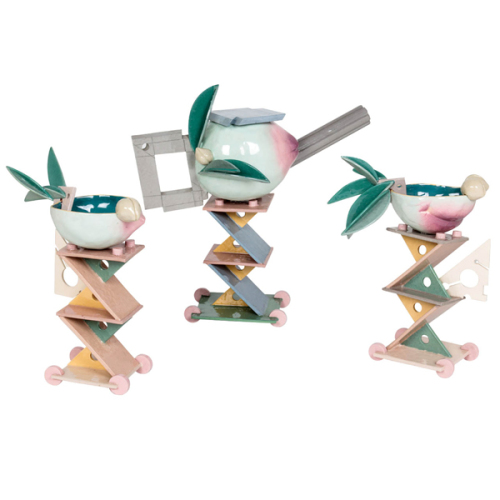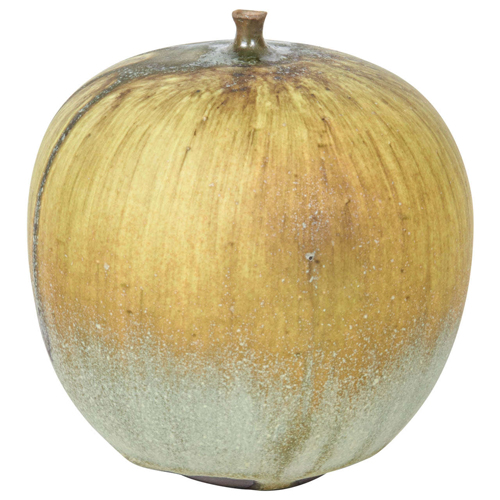1980
-
Asprey & Co., Important Cardinal Sculpture gem set with natural rubies, 18K gold and amethyst quartz, signed,1980
ASPREY & CO. LTD. (founded 1781) London, UK
Important Natural Ruby Gem Set 18K Gold Cardinal Bird Sculpture 1980
Finely chased and chiseled 18K yellow and white gold realistically rendered sculpture of a Cardinal bird set with
85+ carats (approx.) of natural gem quality oval and round cut Burmese rubies (GIA certificate) further heightened with enamel eyes and blackened gold face plumage details, the 18K gold and natural ruby cardinal sets atop a natural Amethyst crystal “mountain rock” with a tooled and gilt (script mark) on the leather under-pad.Marks: A & Co. (in a quatrefoil), Crown mark, 750 (gold standard mark) Lion’s head (London assay mark) “F” date mark for 1980, tooled and gilt Asprey (script mark) on the leather under-pad
Provenance: Privately commissioned by the Sultan of Brunei’s younger brother, Prince Jefri Bolkiah who also later became the owner of Asprey & Co in the 1995. This rare sculptural 18K gold and natural ruby Cardinal was handmade by the finest jewelers and work masters in the workshop of the London Asprey & Co. located above the flagship store at 167 New Bond Street.
H: 3 ¾” x L: 5 3/4” x W: 1 ½”(Cardinal only)
H: 6” x W: 6 ¾” x D: 5 ¾” (with Cardinal atop natural Amethyst crystal rock)As one might guess, a large part of the animal symbolism of the cardinal comes from the brilliant red color of the males. In fact, its name is derived from the royal red vestments worn by Catholic cardinals. This shock of red, especially against the stark backdrop of winter snow, is a magnificent sight. The male cardinal reminds us passion, warmth and vibrancy is available to us – even under the cloak of Winter’s grey clouds. Interestingly, the more bold and bright his color is, the more successful the cardinal will be at prolonging his lineage. Dull colored male cardinals are less likely to mate successfully than bright colored ones. True to the fire of his color, the crimson cardinal has got some major spunk. He will aggressively defend his territory, and fight attackers with ferocity. Indeed, they have been known to fight ghost males (their reflections) in mirrors for hours on end. Both male and female give us glorious songs. Along with peeps and pips and warbles, the tuned ear can also hear “cheer, cheer, cheer!” Very appropriate to the animal symbolism of cardinals, because they are a delight to both eyes and ears. The cardinal makes a fantastic animal totem. It reminds us to hold ourselves with pride, not ego pride but rather the cardinal asks us to stand a little taller, be a bit more regal and step into our natural confidence as if we were born to lead with grace and nobility. Those who attract the cardinal as their totem are naturally energetic, love life, and happily help others where and when they can!
-
Peter Shire Memphis Group California Art Pottery Rare Early “Peach Tea Set” 1980
PETER SHIRE (b. 1947) USA
Rare and early “California Peach” teaset 1980
Handmade earthenware with polychrome glazes
Made by Shire at his studio in Echo Park, CaliforniaSigned: Shire 1980 EXP (painted on base of each)
Model illustrated: Tempest in a Teapot, the Ceramic Art of Peter Shire, Norman M. Klein et al. (New York: Rizzoli, 1991) p. 11.
Teapot H: 10” x W: 11 1/4” x D: 5 1/2”
Pair of teacups H: 7 3/4” & 8”Price: $8,500
Peter Shire (born 1947) is a Los Angeles artist. Shire was born in the Echo Park district of Los Angeles, where he currently lives and works. His sculpture, furniture and ceramics have been exhibited in the United States, Italy, France, Japan and Poland; Shire has been associated with the Memphis Group of designers, has worked on the Design Team for the XXIII Olympiad with the American Institute of Architects, and has designed public sculptures in Los Angeles and other California cities. Shire has been honored by awards for his contribution to the cultural life of the City of Los Angeles.
-
Rose Cabat/American Studio Ceramics Rare “Feelie” Porcelain Vessel, c. 1980-85
ROSE CABAT (1914-2015) USA
Rare and important large scale “Feelie” c. 1980-85
Thin walled porcelain vessel with a silky satiny matte drip glaze
Signed: incised CABAT on bottom
For more information on Rose Cabat see: Rose Erni Cabat Retrospective 1936-1986 (Tuscon, AZ: Tuscon Museum of Art, 1986)
H: 3 5/8″
Price: $1,650
Rose Cabat was an American studio ceramicist living in Tucson. Considered one of the most important ceramic artists of the Mid-century Modernist movement, Cabat is best known for her innovative glazes on small porcelain pots called “feelies” which she developed in the 1960s. Her organic forms often resemble the shape of onions and figs, and her glazes range from organic to jewel tones. Cabat was born in 1914 in the Bronx, New York, began to work in ceramics in the late 1930′s, and moved to Arizona in 1942, where she continued to make innovative ceramics.
Feelies:
Feelies are described as onion, fig, cucumber, and saucer-shaped ceramic vases terminating in an upward closed neck. Bruce Block, an avid collector, has described them as sensual and tactile with a very specific unforgettable texture, spiritual seeming to contain a type of energy. Rose Cabat had developed a silky satiny glaze, and it wasn’t until around 1960 that she had hit upon the first of the appropriate form, svelte and sleek to match the glaze. She exclaimed, “Now this one’s a feelie.”, coining the term. Upon developing the new glazes, she felt that she needed new forms to apply the glazes to, different from what she made before, “craft fair” style coiled heads and wind bells. She is quoted as saying, “The old things did not look good … I wanted simpler shapes that went with the glazes.”They are typically globular in shape, tightening down to a minuscule neck glazed to a satin surface. The tactile experience is most important. The nature of the neck is such that it is closed, so narrow that it cannot hold anything. Cabat would reply when asked why the necks of her feelies are so narrow, “A vase can hold weeds or flowers, but can’t it just be a spot of beauty?” -
Barry L. Thumma, Face of America, Gelatin silver print 1980
BARRY L. THUMMA (1947-2003) USA
Face of America 1980
Gelatin silver print
Size: H: 13 3/8” x W: 11”
Size (with board): H: 14” x W: 11”
Size (framed): H: 21 ¼” x W: 17”
Price: $2,750
Barry L. Thumma, a former New Era photographer, covered four presidents as White House photographer for The Associated Press. In his 20-year career with the AP, he traveled on more than 100 Air Force One flights to photograph presidents Jimmy Carter, Ronald Reagan, George H.W. Bush and Bill Clinton. He also photographed Pope John Paul II, Jerry Falwell, Mikhail Gorbachev, Michael Deaver, Alan Greenspan and Donald Rumsfeld, among other personalities and politicians of his time. He was a member of the White House News Photographers Association. Thumma began his career in 1967 as a part-time photographer for the Lancaster New Era. He joined the Associated Press in 1973 in Cincinnati, where he covered the Reds and the Bengals. After two years as the Ohio photo editor, Thumma moved to Washington, D.C. to cover the White House. He also captured heartbreaking images of the famine in Ethiopia, NASA space flight operations and troop actions in the field.




